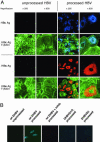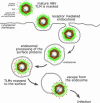Identification of a structural motif crucial for infectivity of hepatitis B viruses
- PMID: 16618937
- PMCID: PMC1458949
- DOI: 10.1073/pnas.0509765103
Identification of a structural motif crucial for infectivity of hepatitis B viruses
Abstract
Infectious entry of hepatitis B viruses (HBV) has nonconventional facets. Here we analyzed whether a cell-permeable peptide [translocation motif (TLM)] identified within the surface protein of human HBV is a general feature of all hepadnaviruses and plays a role in the viral life cycle. Surface proteins of all hepadnaviruses contain conserved functional TLMs. Genetic inactivation of the duck HBV TLMs does not interfere with viral morphogenesis; however, these mutants are noninfectious. TLM mutant viruses bind to cells and are taken up into the endosomal compartment, but they cannot escape from endosomes. Processing of surface protein by endosomal proteases induces their exposure on the virus surface. This unmasking of TLMs mediates translocation of viral particles across the endosomal membrane into the cytosol, a prerequisite for productive infection. The ability of unmasked TLMs to translocate processed HBV particles across cellular membranes was shown by confocal immunofluorescence microscopy and by infection of nonpermissive cell lines with HBV processed in vitro with endosomal lysate. Based on these data, we propose an infectious entry mechanism unique for hepadnaviruses that involves virus internalization by receptor-mediated endocytosis followed by processing of surface protein in endosomes. This processing activates the function of TLMs that are essential for viral particle translocation through the endosomal membrane into the cytosol and productive infection.
Conflict of interest statement
Conflict of interest statement: No conflicts declared.
Figures





Similar articles
-
The machinery for endocytosis of epidermal growth factor receptor coordinates the transport of incoming hepatitis B virus to the endosomal network.J Biol Chem. 2020 Jan 17;295(3):800-807. doi: 10.1074/jbc.AC119.010366. Epub 2019 Dec 12. J Biol Chem. 2020. PMID: 31836663 Free PMC article.
-
Viral and cellular determinants involved in hepadnaviral entry.World J Gastroenterol. 2007 Jan 7;13(1):22-38. doi: 10.3748/wjg.v13.i1.22. World J Gastroenterol. 2007. PMID: 17206752 Free PMC article. Review.
-
pH-independent entry and sequential endosomal sorting are major determinants of hepadnaviral infection in primary hepatocytes.Hepatology. 2006 Sep;44(3):685-93. doi: 10.1002/hep.21297. Hepatology. 2006. PMID: 16941679
-
The translocation motif of hepatitis B virus envelope proteins is dispensable for infectivity.J Virol. 2007 Jul;81(14):7816-8. doi: 10.1128/JVI.00224-07. Epub 2007 May 9. J Virol. 2007. PMID: 17494068 Free PMC article.
-
[Dynamics of HBV covalently closed circular DNA: amplification and clearance].Zhonghua Gan Zang Bing Za Zhi. 2009 Oct;17(10):794-6. Zhonghua Gan Zang Bing Za Zhi. 2009. PMID: 19874702 Review. Chinese. No abstract available.
Cited by
-
Infectivity determinants of the hepatitis B virus pre-S domain are confined to the N-terminal 75 amino acid residues.J Virol. 2007 Jun;81(11):5841-9. doi: 10.1128/JVI.00096-07. Epub 2007 Mar 21. J Virol. 2007. PMID: 17376925 Free PMC article.
-
Duck hepatitis B virus requires cholesterol for endosomal escape during virus entry.J Virol. 2008 Nov;82(21):10532-42. doi: 10.1128/JVI.00422-08. Epub 2008 Sep 3. J Virol. 2008. PMID: 18768975 Free PMC article.
-
Exosomal cell-to-cell transmission of alpha synuclein oligomers.Mol Neurodegener. 2012 Aug 24;7:42. doi: 10.1186/1750-1326-7-42. Mol Neurodegener. 2012. PMID: 22920859 Free PMC article.
-
HBV life cycle: entry and morphogenesis.Viruses. 2009 Sep;1(2):185-209. doi: 10.3390/v1020185. Epub 2009 Sep 1. Viruses. 2009. PMID: 21994545 Free PMC article.
-
Alcohol and Viral Hepatitis: Role of Lipid Rafts.Alcohol Res. 2015;37(2):299-309. Alcohol Res. 2015. PMID: 26695752 Free PMC article. Review.
References
Publication types
MeSH terms
Substances
LinkOut - more resources
Full Text Sources
Other Literature Sources

